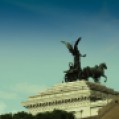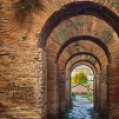Destination: Rome (-plus Milan, Palermo and Genoa)
- Mission 1: ‘Roam’ around the Roman ruins (ACCOMPLISHED);
- Mission 2: Ride down Italy’s cobbled streets on a Vespa (ACCOMPLISHED);
- Mission 3: Stroll around Mussolini’s fascist model district (ACCOMPLISHED);
- Mission 4: Visit one of the famous northern lakes (Como/Garda) (ACCOMPLISHED);
- Mission 5: Explore the macabre Catacombe dei Cappuccini (Sicily) & life-like mummies (DEFERRED);
- Mission 6: Brave-it into the mafia stronghold; the Vele di Scampia, Napoli (DEFERRED);
- Mission 7: Visit one of Italy’s three active volcanoes and Pompeii (DEFERRED).
Highlight: EUR– a perfect-yet-“fascist” utopia.
Lowlight: Catcalling. It’s a pity that not all Italian blokes can behave themselves in public.
Feat of Architecture: The Pantheon, purely for standing the test of time, featuring the largest unsupported dome in the world today.
Recce fact: In 2016, the former PM announced that everyone born in 1998 would receive a €500 “culture bonus” on their 18th birthday to be spent on spend on culture, from concert tickets, books and museum admission etc. Youth unemployment in 2016 was at almost 40%. Perhaps a Rihanna concert will cheer them up?
There are two types of people:
Italy has such a rich historic culture which will certainly appease the former type of folk with their refined tastes, but if you are a modern latter type and don’t care much for decrepit old ruins but rather favour the contemporary, then Italy also has plenty to offer.
First Impressions
Having visited Italy numerous times for work and leisure, it was finally time to grace the capital; the heart of the Roman civilization with its cobbled roads, ancient ruins overlooking the city from the hills, scooters darting and weaving in and out of traffic and sightseers galore. It has an entirely different feel to any of the other major Italian cities that I have been to. Italy, with its 20 regions is really not unified and never has been. But whether you’re into history, art, archaeology or you just agreed to come purely for the pizza and gelato, it is impossible not to be visually impressed by Rome. I mean, for Pete’s sake, the Colosseum is almost 2000 years old. Wembley Arena or Madison Square Garden will have surely seen better days by the year 4000.

Watching Italian people can be a bit like a theatrical performance sometimes because they are so emotive and expressive, and I’m convinced that if you tied their hands behind their backs they would be incapable of holding so much as a telephone conversation. They always seem glad and willing to explain Italian culture to anyone curious about it and I haven’t yet met any who weren’t extremely knowledgeable (or at least opinionated) when it comes to the nuances of Italian cuisine and the Italian way of life in general. Even the boldness when they tell you that you’re doing everything wrong and the Italian way is best has a certain charming quality to it. To stand bravely in the face of a turbulent political history, festering corruption and serious questions over continued economic survival and defiantly inform others that they don’t know (a) real car \ bread \ wine \ luxury \ art \ landscape \ tomatoes until they’ve driven \ tasted \ tried \ worn \ seen Italy’s very own Maserati GranTurismo \ foccacia \ Barbaresco \ Corneliani \ Michelangelo \ Tuscany \ pomodori etc. is admirable, and very few would dispute.
Ancient Roman Sites
It must be exceedingly difficult to get planning permission in Rome with the necessity of safeguarding all the ancient infrastructure. Most of the iconic sites are within convenient walking distance of each other and you can avoid the queues by booking tickets in advance, as every savvy traveller knows. However, if you would rather throw caution to the wind and join the Disneyland-esque queues, then just be sure to double the duration of your trip.
Two snippets of advice about the Colosseum: 1) make sure you go and see it during the day and also at night, as this offers very different but equally spectacular picture opportunities; 2) don’t bring a handbag/rucksack of any description, or you won’t be allowed in. It is the largest amphitheatre in the world, and has suffered more than its fair share of earthquakes, vandalism and fires. It is worth going inside purely to appreciate the complexity of all the underground passages and dungeons under what was once the arena itself.
Another monument also in the region of 2000 years old is the Pantheon, which is in incredible nick. Originally constructed as a temple to the Roman gods, it has served as a church since 609 AD. The dome is allegedly the largest unsupported dome in the world today and it’s clear that there was a great deal of engineering expertise that went into its design. The 30ft diameter hole (‘oculus’ actually) annually gives rise to a special lighting phenomenon, hence recent theory has emerged that the unique design was actually intended to serve as a colossal sundial.
One of the oldest temples/theatres in Rome (Largo di Torre Argentina) is now home to a 150+ cat sanctuary and it is in this very spot that Julius Caesar met his bitter end by assassination. The cats are very friendly and can be seen lazing among the columns and lounging in the shade. Italy has a no-kill policy for stray cats and thus depend on the good work of sanctuary volunteers to control the population and provide food.
“Et tu, Brute?
The Roman Forum (Foro Romano) was the true heart of the ancient city of Rome, situated below Palatine Hill (the central of the Seven Hills and once home to Rome’s most wealthy). Here, one can freely explore the original temples, squares, residential areas and Senate House.

Of all the dreadful and brutal Roman Emperors, Nero perhaps takes the biscuit. He killed his own mother (albeit she wasn’t the most popular of women and was thought to be plotting to kill him first), his first wife and possibly even his second in a very barbarous manner (if there is indeed truth in it). It is unclear whether or not he was responsible for starting the Circus Maximus fire that burnt much of Rome to the ground, but he certainly did make use of the newly cleared site to construct himself a grand palace, the Domus Aurea. This endeavour was highly contested by the people of Rome, as the empire was suffering financially, taxes had to be raised and there he was meanwhile intent on constructing an extravagant golden portico villa complete with a 36m bronze statue of himself and artificial lake, where other members of the public used to dwell before the fire. The army eventually revolted, civil war broke out, Nero topped himself and that was that. Domus Aurea is a bit of a worksite at the moment, with various restoration efforts going on, but the original pedestal can still be seen where the giant bronze Nero (who later had his head replaced with Apollo’s) once stood.
The Best of the Rest
Even in November, be sure to arm yourself for battle when trying to get near any of the key tourist attractions. If there was ever a time that I wanted to batter people with their selfie sticks, it was then. Yes-yes, I know, pot-kettle, but my tourism is more important; I’m on a mission, don’t they know! And so I pressed on into the masses surrounding Fontana di Trevi (Trevi Fountain; so called because the original Roman era fountain was located where tre vie (three roads) met), receiving dirty looks from people when I infringed upon their selfie glamour shots. In its current form, it is over 250 years old. €3,000 is thrown into it daily by tourists in accordance with the old wives’ tale that if you toss a coin over your shoulder, you’ll one day return to Rome. I wonder if throwing in 1 cent still counts? A two-euro coin seemed excessive. Time will tell.
The single most impressive building in the whole of Rome for sheer size and grandeur? The Altare della Patria, especially when illuminated at night. As the largest building in all of Rome, it will just blow you away. Italians mockingly call it names such as “the wedding cake” (“la torta nuziale”) and I suppose it does bear a striking resemblance.
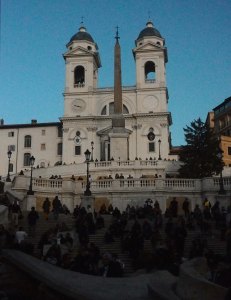
The 18th century Spanish Steps (Scalina Spagna), contrary to popular belief, are not called as such due to being adjacent to Spanish Square (named after the Spanish Embassy to the Holy See), no. It is actually because you will find dozens of Spanish students sitting on them at any time; fact (maybe). A drunken Colombian man reckoned he was in the Italian Job when he attempted to drive his Toyota Celica coupe down the Spanish Steps some years ago before getting stuck and swiftly arrested.
Piazza Navona is one of the main plazas that everyone speaks
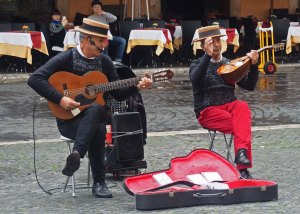
enthusiastically of. Like most famous European central plazas you’ll find fine restaurants, entertainers and overpriced gift shops. But when I later read that it is actually the original site and shape of the Stadium of Domitian, it became instantly more intriguing. Now these buildings stand where the original arcades once were (which were at one stage brothels, allegedly) and where up to 20,000 spectators would come to watch athletic events in ancient Roman times. As with all tourist hotspots around Rome, there is a constant military presence of heavily armed soldiers carrying M16s in Piazza Navona. There have been recent protests at the Colosseum (October 2016) in response to the state closure of several makeshift mosques. Italy does not officially recognize Islam as a religion, despite 2-3% of the population identifying as Muslim, and as such it is not entitled to any state funding. This is something that is likely to progress in the future.
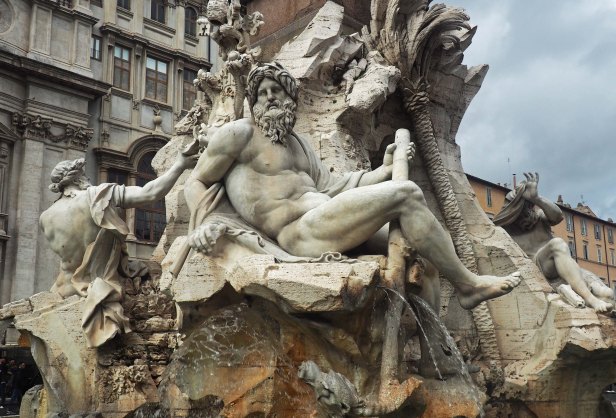
Tiny Cars, “Wasps” and Creative Parking
You may have seen this hilarious and accurate animation about Italian vs. European behaviour. First and foremost, Italian roads may be chaotic but Italians are not bad drivers by any means. One has to be incredibly alert to avoid the “scootilla” of scooters whizzing around and weaving in and out of cars. Not only that, but the cobbled roads of Rome are often without clear road markings and make for a bumpy ride. But the award goes to Italian drivers for ingenious parking techniques. Nowhere else in the world will you surely see scooters and tiny cars (which Italians are so dearly fond of) packed so efficiently by the roadside, with barely a centimetre spared. Now what happens when someone wants to get out? I honestly do not know. Do they leave their handbrakes off so someone can give them a push? Do they bump them forward ever so gently? Or do they simply linger around the osterie until the first vehicle moves? Given the lack of queuing philosophy in Italy, I’d say the latter is a lot less likely.

Alas, there were far more Audis than “Alfas” on the roads, but all is not yet lost to globalisation, as there are still many famous Italian auto brands everywhere you look. The Vespa (wasp) may be celebrating its 70th birthday in 2016, but mopeds and scooters are still the go-to mode of transport, well suited to the narrow streets of Rome. In post-war Italy they were essential for getting from A to B when the infrastructure was in ruins and what’s more, they were cheap and reliable. After La Dolce Vita was released, people around the world wanted to follow suit. Well, as the saying goes, “He who Vespas, shines” (that’s right, Vespa is a verb now). Personally, I reckon I’d shine much more in a Maserati…
Mussolini’s Fascist Suburb (EUR)
It’s official; I have found the perfect city model. And whom do I have to thank? None other than Il Duce, Benito Mussolini. Now primarily a business district located 10km from the centre of Rome, it was originally intended to host the grand event that never was; the 1942 World’s Fair celebrating 20 years of Fascism. WWII began and the expo never took place, the Pact of Steel (with Nazi Germany) dissolved, Italian military weaknesses meant embarrassing defeats in Africa and Greece/Yugoslavia, Mussolini was overthrown, imprisoned, failed escape, and was finally shot along with his mistress by Italian partisans before is corpse was hung upside down in the streets of Milan for public desecration/mutilation. In spite of all his wrongs and failure to “invoke classical Rome”, he did achieve a small-scale utopia that is EUR.


It is truly immaculate, flitting between Italian rationalist architecture à la Pagano (typically non-ornamental, simplistic and highly regular in shape) and the simplified neoclassicism of Piacentini. The only drawback? These styles were the epitome of Fascist architecture, also admired by Adolf Hitler. Of course, it’s not that the style has any direct relationship with fascism other than being popular among fascist regimes, but it does command respect and exudes an authoritarian vibe. Unlike other modernist architecture emerging throughout Europe at this time, the Italian Fascist concept was distinctly different. You won’t find concrete here except on the pavements of the exceptionally wide roads and avenues. The buildings were inspired by ancient Roman architecture, albeit sticking rigidly to geometric shapes and without the bells and whistles, and as such, were crafted from robust materials such as limestone, marble etc. This gives EUR a very clean, white appearance.
It greatly saddens me that masses of people may go to Rome and never be told that there is a Square Colosseum, or a modern Pantheon. It begs the question, if the district is an undesirable reminder of the fascist era and is hence better kept secret. Either that, or it’s thought that tourists would find it artificial, boring and lacking in charm (sacrilege, I say). I noticed plenty of cars but very few people walking on the streets; completely refreshing after the chaos of Rome. You can walk around the entire district easily on foot, finishing off at the cherry-on-top; PalaLottomatica, the dome on a hill surrounded by a man-made lake. Next time, I shan’t leave without going up to the restaurant in “Il Fungo” (the Mushroom); an impressive concrete tower which serves to provide water for the EUR gardens.
Impending Economic Collapse?
Italy may be the third largest economy in Europe at present, but it is also a ticking time-bomb which could seriously upset the entire EU apple-cart, should it descend into further chaos and an economic downturn. For better or for worse, Renzi’s massively technical and complicated reform was rejected (not surprisingly as ordinary people failed to grasp the full implications of it) which led to him stepping down as Prime Minister towards the close of 2016. It begs the question of whether or not governments should continue holding referendums on such highly complex and critical decisions in the name of democracy, when the facts and serious implications are relatively unknown, or else buried in a sea of lies, false accusations playing on people’s worst fears and nonsense statistics (à la Brexit). When will an Italian government once again reach the end of its term? Silvio Berlusconi has a lot to answer for, as the embodiment of everything that is wrong with Italian politics with all his scandals and blatant corruption, but in spite of all, he is quite the character and just oozes charisma. Italy must continue to push those high-quality exports and keep the banks from going under; the clock is ticking.
Vatican City
Technically, Stato della Città del Vaticano constitutes its own state, giving me two missions for the price of one (hurrah!). See Mission Vatican City – coming very soon.
Elsewhere within the Boot & Football
Remember in school when the teacher explained that the geography of Italy was like a high-heel knee boot kicking a deflated football? There is a well-known stereotype that divides Northern and Southern Italians, as summarised very neatly in this article. As the saying goes, “For every church in Rome, there’s a bank in Milan”. Northern Italians are characteristically hard-working, punctual and frosty, whereas Southerners are renowned for being idle/lazy, laid back, loud and tend to be more religious. That sounds suspiciously like a set of stereotypes conceptualised by Northerners as Southerners get the bad deal, but I suppose the implication is that they are warmer and enjoy life to the fullest. Not sure how Rome fits in, as it seems to be a halfway house. But allow me to say a few brief words about my other encounters in Italy:
- Lake Como was distinctly average, despite how it looks in online photos. The water wasn’t even blue but a murky green. Though in all fairness it was just a grey old day.
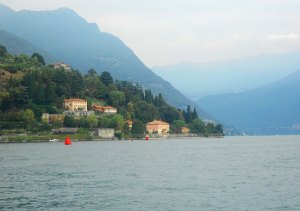
- Palermo (Sicily) felt like being lost in a 90s Mafia film set. For reasons best known to themselves, my aunt and uncle thought it would be fine to let two 16 year old fair-haired girls walk around the city alone at night after dark. Let’s just say this how I fulfilled Mission 2: Ride down the cobbled streets on (the back of) a Vespa, in pursuit of some bloke named Giuseppe who had run off with my cousin. It was on the same night that I was introduced to backstreet alley liquor establishments without seating.
- Milan was an entirely different kettle of fish; classy, efficient, public transport runs on time, ambient revving and growling of Ferraris and Lambos, people mind their on business and men don’t harass women in the street (much). The only downside is that I have never felt so underdressed in my life. The Milan Cathedral (Duomo di Milano) is spectacular, especially when viewed from an overlooking balcony with Prosecco-in-hand.
- Genoa/Arenzano and that general part of the Riviera was tranquil, although (like much of Italy) the hotels are very dated. The coast looks nice but it’s a dark, stony beach; the kind that hurts to walk on. I was so unlucky with Genoa that I hopped back on the return train after a mere 20 mins because there were so many shifty-looking individuals about. Clearly I was in the wrong place at the wrong time (story of my life).
Italy is still an incomplete mission, as after watching Italian crime film Gomorra (2008), I decided that I absolutely have to visit Napoli, and in particular that architectural masterpiece (and slum) which is the deteriorating urban housing project, Vele di Scampia.
Italy has three, not dormant, but active volcanoes; Mount Etna (Sicily), Stromboli (Aeolian Islands) and lastly, Mount Vesuvius; responsible for burying the ancient cities of Herculaneum and Pompeii. The country has had more than its fair share of seismic activity of late. Let’s hope there will never be another disaster of that magnitude seen again.
Food of Italy
Italian cuisine? Where does one begin. Every small village in Europe seems to be equipped with an “Italian restaurant” but how close are our Italian restaurants to the real deal? One thing I have come to realise is that Italian cuisine varies significantly by region. Usually it’s a stand-off between Italian and French cuisine for the ultimate culinary prize, though I still can’t understand what all the fuss is about, or how Italians do not get fat (good genetics?). Pasta is allegedly “Baby’s” first proper food in Italy; more or less being weaned on it, so naturally it forms the staple diet. Things I previously didn’t know: true carbonara sauce doesn’t contain a single drop of cream; Pizza Romana is thin, light and crispy whereas Pizza Napoletana is thicker, more doughy and popular outside of Italy; and meat dishes are usually served as a separate course by which stage you’re usually too full to eat it (apparently it doesn’t all go down the same way…who knew?). Coffee is serious business. “Tea is for sick people”. I couldn’t find a sit-down cafe anywhere in Ciampino; instead the custom seemed to be to stand at a coffee “bar”, knock back the shortest caffè you have ever seen and be on your merry way again. It was however refreshing to escape the usual obnoxious grande-sized made-up-uccinos with fake-milk foam and saccharine-drizzle.
In one restaurant, the waiter scolded me for practically inhaling my food. “You should take your time, relax, look… admire the green-ness of this plant on the table, enjoy life“. I don’t have time to stop and smell the flowers. This is Reconnaissance Europe, not Stagnating Europe. I’d really have enjoyed it more if waiters let me dine as a please and refrained from trying to give me their phone numbers written on the bill! Ladies, try not to get irate like me by the absurd and often flagrant flirting. They mean no harm, honest.
I’m genuinely sorry for the outlandish opinion, but I am not a raving fanatic of Italian food. It’s all either terribly decadent (cheese on everything, carb-city, olive oil mania and artificial-tasting cream-laden desserts) or else ridiculously plain (gnawing on plain bread and focaccia without condiments, or a simple pasta dish with tomato sauce supposedly constituting a meal). And for every gem of a restaurant there are probably half a dozen stale old trattorias. I would even be as bold as to say that Argentina does an equally good interpretation of Italian cuisine. They have sorrentinos, fugazza and a host of other specialties (and you won’t find any of these nor the fabulous pasta delicatessens in Rome like you do in Buenos Aires). This is owed to the fact that more than half of the population of Argentina have Italian descent. You might be lucky enough to stumble upon some cuisines from the former Italian Empire if you fancy changing-it-up, e.g. Eritrean restaurants.
On a final note, Prosecco is one of the small things that make life all that more enjoyable. I also recommend Cynar; a bitter herb liqueur made primarily from artichokes.
Sounds of Italy
We all know and appreciate the Andrea Bocellis and Pavarottis of the Italian classical world, and Rome’s own Cecilia Bartoli; glory be…that lady can sing compositions that were never ever intended to be sung by any human being; respect. In the metal world, Italy proudly exhibits Lacuna Coil fronted by dark beauty Cristina Scabbia. Whilst in the dance and electronic music realm, one can find everything from the upbeat sounds of Gigi D’Agostino to the hardcore blasts of (my personal favourites) the masked Meccano Twins (a.k.a. Art of Fighters). I’d like to give one other band a special mention, despite the fact that they were never all that famous; CCCP Fedeli alla Linea, an 80s punk band formed in Berlin. Why were they so special? They blended a fusion of genres, thus rejuvenating stale punk, incorporating industrial sounds with oriental sounds, folk music, electronic music with expressionist (frankly bizarre) stage theatrics, all under the guise of being “pro-Soviet” and fondly remembering the good old socialist ways. However, their lyrics also criticised the Soviet regime and made parodies of certain aspects of the sociopolitics, but songs (such as “Punk Islam”) are guaranteed to get stuck in your head nonetheless.
Mission Italy Summary
I shall conclude with a highly subjective reconnaissance rundown of Italian cities: Palermo– a picturesque gangster’s paradise, Milan– where things are organised and run like clockwork but you’ll feel considerably underdressed, Genoa– pleasant enough riviera close-by but dodgy in places, Rome– fast-paced, chaotic and full of tourists all year round but you’ll be pressed to find anywhere as visually/historically impressive anywhere else on the continent. Next missions: surviving the Camorra gang stronghold in Scampìa, Napoli and the (hopefully inactive) Mount Vesuvius.



































